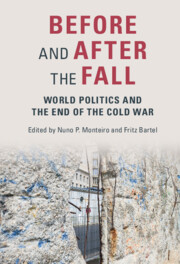Book contents
- Before and After the Fall
- Before and After the Fall
- Copyright page
- Dedication
- Epigraph
- Contents
- Figures
- Tables
- Contributors
- Preface
- Introduction
- Part I Sources of Continuity and Change
- Part II Continuity and Change Across the 1989/1991 Divide
- Part III Toward a New World Order?
- 12 Great Powers and the Spread of Autocracy Since the Cold War
- 13 Seeds of Failure
- 14 The United States and NATO After the End of the Cold War
- 15 The Historical Legacy of 1989
- 16 Requiem for a Cold War
- 17 After Primacy
- 18 World Order across the End of the Cold War
- Index
12 - Great Powers and the Spread of Autocracy Since the Cold War
from Part III - Toward a New World Order?
Published online by Cambridge University Press: 02 December 2021
- Before and After the Fall
- Before and After the Fall
- Copyright page
- Dedication
- Epigraph
- Contents
- Figures
- Tables
- Contributors
- Preface
- Introduction
- Part I Sources of Continuity and Change
- Part II Continuity and Change Across the 1989/1991 Divide
- Part III Toward a New World Order?
- 12 Great Powers and the Spread of Autocracy Since the Cold War
- 13 Seeds of Failure
- 14 The United States and NATO After the End of the Cold War
- 15 The Historical Legacy of 1989
- 16 Requiem for a Cold War
- 17 After Primacy
- 18 World Order across the End of the Cold War
- Index
Summary
Over the past century, Great Power transitions have led to the spread of autocracy in two distinct ways. First, the sudden rise of autocratic Great Powers led to waves of autocracy driven by conquest but also by self-interest and even admiration, as in the fascist wave of the 1930s or the post-1945 communist wave. Second, the sudden rise of democratic hegemons led to waves of democratization, but these waves inevitably overextended and collapsed, leading to failed consolidation and rollback. While these two categories - rollback from democratic overstretch, and hegemonic authoritarian cascades - both look like autocratic diffusion, they stem from very different causes. This chapter examines the relationship between Great Power transitions and regime diffusion. A key question is whether modern democratic decline is a post-1991 correction – that is, the delayed but inevitable overstretch of the post-Soviet wave – or the beginning of a distinct new wave of autocracy.
- Type
- Chapter
- Information
- Before and After the FallWorld Politics and the End of the Cold War, pp. 225 - 243Publisher: Cambridge University PressPrint publication year: 2021



